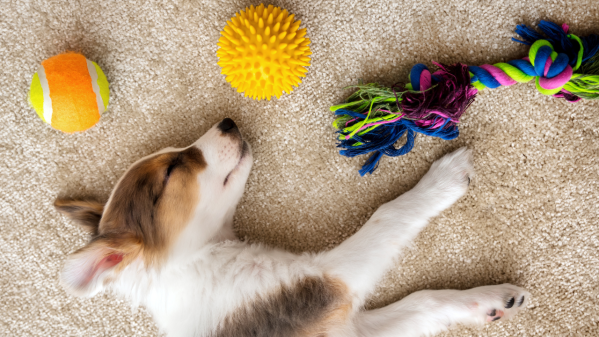With their keen sense of smell and adventurous, curious attitude, it’s natural that dogs sometimes get into items that they’re not supposed to. However, when the item that your dog finds could be potentially hazardous and lead to vomiting, diarrhea, and other symptoms, it can make for an extremely stressful situation.
In even more dire cases, the objects that your dog erroneously consumes could lead to real problems with their insides or intestines. That’s why being a diligent pet parent is key, and being conscientious about what your dog is snacking on is essential. You might even want to consider phasing out certain plastics for a pet-friendly home.
Plastic is one of the most abundant man-made products. There are plenty of opportunities for our canine companions to accidentally snag and eat some plastic.
While it can be very tempting to start panicking, it’s important that you remain calm. When you panic, your dog will follow suit. Try to maintain your cool and think as tactically as possible regarding how you're going to seek help for your pet.
What happens when a dog eats a plastic bag?
Unfortunately, if your dog ate a plastic bag, there are several adverse symptoms that can occur. It’s important to learn about these to understand why rapid intervention to help ensure your pet’s safety is necessary.
Airway obstruction
The first potential risk is airway obstruction. This could be hazardous as it could make it extremely difficult for your dog to breathe. Your pet might sound like they are choking or coughing, they might appear weak and unable to walk around, or you might even see their gums appearing pale, grayish, or blueish. If you fear that your pet is experiencing this after they ate a plastic bag, you should reach out to your vet immediately.
They will know how to help your pet and will likely stress how rapidly the situation needs to be addressed to increase your animal’s chances of making a full recovery.
Esophageal injury
Next, esophageal injury is also a risk for pets that have consumed a plastic bag. The esophagus is an important organ for your pet because it carries food from their mouth all the way to the stomach.
When the esophagus sustains an injury, that limits its ability to successfully execute its job. Symptoms of this will include choking or coughing, repeated swallowing or stretching of the neck, and discomfort when swallowing. Your dog might also refuse to eat or only want to eat soft food. There are several treatment options for an esophageal injury, but again, it’s essential that you bring your dog to the vet in a timely manner.
Stomach or intestinal blockage
If your dog got their paws on a plastic bag, they are also at risk for a stomach or intestinal blockage. This basically means that the plastic bag could get stuck somewhere in the stomach or intestine and block anything else from getting past it, preventing your pet’s gut from functioning normally. Plastic bags can also sometimes act like string in the intestine and cause a ‘linear foreign body’. This is a medical emergency and needs to be treated immediately. Symptoms of a blockage include inappetence (not wanting to eat), vomiting, no stool production or small amounts of diarrhea, lethargy, dehydration, and abdominal pain.
Ultimately, this could lead to other significant problems for your pet. If you are concerned that they consumed something they were not supposed to eat and have a stomach blockage as a result, seek prompt medical attention.
What happens if my dog ate plastic that is sharp?
A plastic bag can certainly be hazardous for your pet, and unfortunately, if they get their paws on sharp pieces of plastic, this material might pose an immediate danger as well.
Sharp plastic can be pointed, rough, or jagged and, therefore, carries a risk of causing damage to soft tissues. If your dog consumed sharp pieces of plastic, they are at risk for experiencing cuts to the mouth, internal bleeding, and even a digestive obstruction.
Mouth lacerations
Animals that swallow sharp pieces of plastic might suffer from mouth lacerations or cuts. This can be extremely uncomfortable and even painful for them to experience and can make it difficult for them to eat
It’s best to try to avoid access to sharp plastic to ensure no lacerations or cuts occur.
Internal bleeding
Because of the sharp, pointed nature of this type of plastic, internal bleeding is possible if your dog ingests a piece of this plastic and it damages the intestine as it moves through the gut. Because internal bleeding occurs inside of your pet’s body, you will have to observe external symptoms to figure out if they're bleeding internally. Symptoms of internal bleeding you should look for include vomiting blood, black and tarry stools, pale gums, lethargy, and a faster than normal breathing rate when your pet is resting. If you see any of these symptoms, you need to take your pet to a vet as soon as possible.
Digestive obstruction
Digestive obstructions can be extremely dangerous for pets. If you worry that your pet might have a digestive obstruction, you should reach out to a vet immediately. Symptoms of a blockage of the intestine include repeated vomiting or heaving, no stools or very small amounts of diarrhea, poor or no appetite, lethargy, and dehydration.
Pawp veterinarian Dr. Sylvalyn Hammond also shares that your dog’s size comes into play when you're considering if they could have digestive obstruction as a result of plastic consumption.
“Smaller dogs are more likely to experience gastrointestinal damage and/or blockage from plastic ingestion than large dogs since their digestive tracts are narrower," explains Dr. Hammond.
So, what should I do if my dog ate plastic?
Firstly, try not to panic, because dogs are able to perceive their humans' emotions and can respond to your anxiety with more stress of their own, making it difficult to assess their behavior accurately.
The most important thing that you can do is talk to a vet as soon as possible. They will be able to work with you to help figure out what the appropriate treatment is to help your pet.
If you're unable to contact your own vet, you can always contact Pawp and our team of veterinary professionals. We know how to help advise you on what your next steps should be to ensure your pet’s safety. Pawp’s vets are available 24/7 for telehealth visits, and there’s never a wait or appointment necessary.
What will the vet do if my dog ate plastic?
Once you bring your pet to the vet to get treated for consuming plastic, your vet will likely proceed with one of these steps.
Monitor your dog
If they do not believe that the situation is dire, the vets will monitor your pet to ensure that no new symptoms pop up. This will likely be your vet’s approach if the pieces of plastic that your dog ate are likely passable or not worryingly sharp. They might attempt to bulk up your pet’s diet to try to get the piece of plastic to move through the intestine quickly and safely.
Perform an x-ray
An x-ray can be helpful in deciphering the extent of the situation. For instance, an x-ray can help the vet figure out if the plastic poses a severe risk for your pet or if they will likely be able to pass it themselves.
Induce vomiting
In some cases, your vet might believe that inducing vomiting is the best way to remove the plastic from your pet’s body. Again, this depends on the size and sharpness of the plastic, so it will vary on a case-by-case basis.
Suggest surgery
Unfortunately, if your pet has a severe digestive obstruction that is preventing their digestive system from functioning normally, surgery will be suggested. The surgery will focus on removing the plastic object, checking for any damage caused by the object, and correcting that as well if necessary.
Ultimately, prevention is better than cure, so preventing your pet from having access to the type of plastics that can break when chewed on and cause potential issues is the best strategy.

Reviewed and fact-checked by
Dr. Mari, DVM at Pawp
